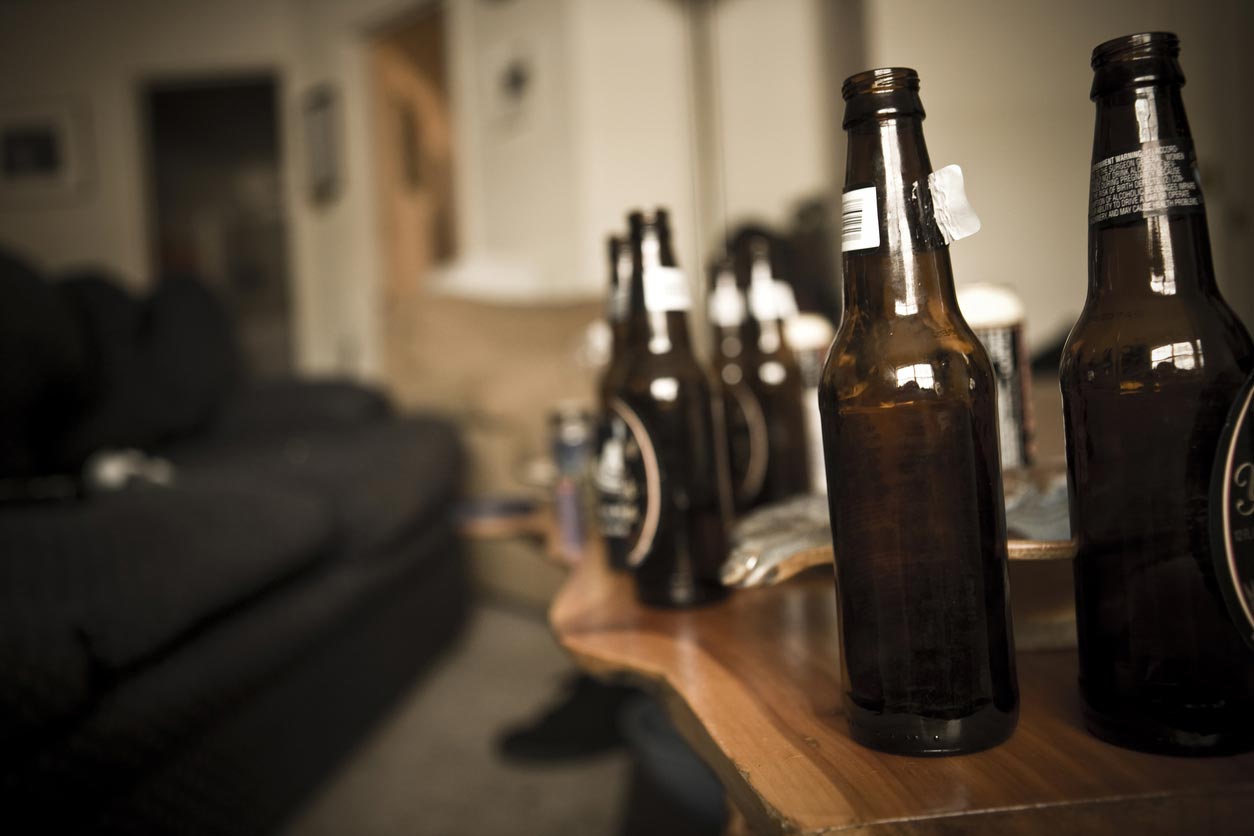The history of humans consuming alcoholic beverages is quite possibly 100,000 years long and spans across almost every culture on Earth. In terms of popularity, alcohol beats out nicotine, caffeine, and the betel nut (the seed of the areca palm, which contains a compound similar to nicotine) as the most widely consumed human psychoactive (mind-affecting) agent around the world. And alcohol use is on the rise. Between 1990 and 2017, the total amount of alcohol consumed yearly around the world grew by as much as 70%. And the effects of alcohol aren’t just limited to temporary intoxication.
There are three widely discussed macronutrients in the human diet: protein, carbohydrates, and fat. But the truth is that many of us are also getting calories from a fourth source that is all-too-often ignored: Alcohol. In fact, the average American gets 160 calories per day from alcohol.
Alcohol is calorically dense, providing seven calories per gram (almost as many as fat!). And the calories that come from alcohol are “empty calories” with no nutritional value. Most alcoholic drinks provide a small number of minerals or vitamins, but not enough to make any positive contribution to your diet. And many also contain added sugar.
Why Is Alcohol so Popular?
Why do people consume alcohol? There are many reasons. Some people love (or have acquired a love for) the taste. There are familial, religious, and cultural traditions bound up with alcohol consumption. Many drinks are considered fun and festive. Some people also drink alcohol for pain relief, both physical and emotional, or to help them get to sleep. Many people rely on alcohol to help them relax from the stresses of their lives or open up at parties and gatherings, a phenomenon known as social lubrication. Some people now consume red wine and beer for their alleged health benefits, which have been widely and loudly hailed by the marketing arms of the alcoholic beverage industry.
Others drink alcohol as an addictive behavior. In fact, an estimated 12% of Americans have been dependent on alcohol at some point in their lives. Studies show that although there’s more to an addiction than genetics, people with a family history of alcoholism generally have a higher risk of becoming addicted themselves.
What is Alcohol?
I don’t want to dive too deeply into the dictionary definitions of alcohol, because if I did, I would have to type phrases like “colorless, limpid, volatile, flammable, water-miscible liquid” and “any of a class of chemical compounds having the general formula ROH where R represents an alkyl group and -OH a hydroxyl group.” Instead, I’ll make it simpler. Alcohol forms when yeast ferments certain carbohydrates, or when humans reproduce that process synthetically.
There are three main types of alcohol. These include isopropyl, methyl, and ethyl alcohol. While ethyl alcohol — also known as grain alcohol — can be consumed by humans, the other two cannot. Instead, they’re often used as fuel or sterilizing agents.
Alcoholic beverages come about by fermenting mixtures of fruit or grains. For spirits like whiskey, rum, vodka, and gin, the fermentations are then distilled, a process that separates out and concentrates some components of the original mash.
Types of Alcohol
For a visual representation of the vast variety of alcoholic beverages we humans have invented, you need not go further than your local liquor store. Some of the most popular types are detailed below, including their typical alcohol content.
- Beer: The types of beer differ mainly depending on the raw ingredients that are fermented and the type of yeast used to ferment them. Beer is usually 4-9% alcohol.
- Wine: Wine comes from wine grapes, which are small, seedy grapes with thick skins. While over a thousand types of wines exist, we often hear of red (which comes, not surprisingly, from red grapes), white, and rosé. Under each of these categories are varieties of wine ranging from light and sweet to dry and savory. Wine is typically 9-16% alcohol.
- Champagne: This is a white, sparkling French wine. While many people consider all sparkling wines to be champagnes, true champagne must come from the Champagne region of France to bear the name. Champagne ranges from 8-15% alcohol content.
- Distilled Spirits: These drinks come about by distilling grains, fruit, or vegetables that have undergone fermentation. Examples include whiskey, rum, gin, and vodka. Distilled spirits range between 40-95% alcohol content. Their higher alcohol content often gives them the “hard liquor” label.
- Hard Cider: Made from the fermented juice of apples, pears, or other fruit, hard cider ranges from 1.2% to 8.5% alcohol in traditional English ciders and 3.5% to 12% in U.S. ciders.
- Hard Seltzer: Also called spiked seltzer, hard seltzer is a mixture of carbonated water, alcohol (often a wine, spirit, or fermented cane sugar base), and usually a fruit flavoring. These are typically 5% alcohol content.
- Kombucha: This is a fermented, mildly alcoholic beverage made from green or black tea and sugar. While traditional kombucha is around 0.5% alcohol content, there are also “hard” kombuchas, which can be closer to 5% alcohol.
Alcohol Effects on the Body
The rate at and degree to which alcohol hits the bloodstream and affects the body can vary between individuals, based on a number of factors. However, the process is the same.
After you consume alcohol, it travels through the stomach and intestines, where it is absorbed. While we can store nutrients, protein, carbohydrates, and fat in our bodies, we can’t store alcohol. In fact, our bodies want to get rid of it as fast as possible. All of the other processes that should be taking place (including absorbing nutrients and burning fat) are interrupted by the body’s urgent need to burn up the alcohol it’s absorbed.
When the body is burning alcohol as a primary source of energy, excess glucose and lipids in the bloodstream end up converting to fat. That’s the biological reality behind the “beer belly.” It’s at this point that we start feeling alcohol’s effects.
The Body’s Filtration System
In the liver, ethanol undergoes oxidation, which is a fancy chemical term meaning “it loses electrons.” An enzyme in the liver called alcohol dehydrogenase removes those electrons from the ethanol, leading to the creation of acetaldehyde, a very nasty chemical that is responsible for all the effects we lump together as a “hangover.” At that point, a second chemical reaction converts, as quickly as possible, the acetaldehyde into a less toxic compound, acetic acid, which is conveniently water-soluble and can, therefore, get out of Dodge via the Kidney Express.
Alcohol also inhibits the secretion of the antidiuretic hormone (ADH) from the pituitary gland. ADH is responsible for helping our kidneys to reabsorb water, so when inhibition occurs, we pee more. Some call this effect of alcohol “breaking the seal.” Alcohol irritates the lining of our gastrointestinal system, increases the blood flow to our stomach, intestines, and skin, and reduces blood flow to muscles. Since our bodies perceive alcohol in any amount as a toxin, our liver goes into overdrive to convert it into acetic acid and remove it from our body.
Alcohol Affects People Differently
How much effect alcohol has on the individual depends directly on two things: the amount of alcohol consumed (which determines the blood alcohol concentration or BAC that results), and the person’s genetic ability to convert acetaldehyde into acetic acid. The liver enzyme responsible for this task is called acetaldehyde dehydrogenase (ALDH). And some people have a gene that produces a sluggish variant of the enzyme. Folks with this slow ALDH do not have a good time with alcohol and tend not to drink very much.
While many people associate alcohol with partying and good times, it’s actually a depressant, or what’s known colloquially as a “downer.” The relaxation that many people feel after drinking is a result of alcohol’s depressive effects on the central nervous system, including the brain. It increases the potency of the neurotransmitter GABA, which regulates our nervous system. While GABA is important for maintaining a positive mood during times of stress, alcohol can enhance GABA’s effect to the point of impairment. In addition to slowing down involuntary bodily functions, excess alcohol can cause us to slur our speech, move unsteadily, and think irrationally, as well as preventing us from reacting quickly (which is a major problem for things like, say, driving a car).
Risks of Drinking Alcohol
Research shows alcohol consumption can increase your risk for chronic diseases, mental illness, and even death.
Here are some ways in which consuming alcohol can impact each part of your body:
- Especially when consumed in quantity, alcohol can compromise your brain health by increasing your risk for Alzheimer’s and other dementias, contributing to memory problems, and worsening depression and anxiety.
- Alcohol consumption may raise your risk for cancers of the liver, breast, mouth, throat, esophagus, and lower digestive tract (e.g., colon and rectum). One reason for this is that heavy alcohol use can lead to folate deficiency, which can trigger genetic changes that increase your risk of cancer.
- Drinking alcohol in excess can lead to failure of organs, specifically the liver, heart, and kidneys.
- If alcohol makes up a large portion of the diet, it can lead to obesity, which raises the risk for obesity-related chronic diseases. And even in smaller quantities, it can add extra pounds since it’s calorically dense and, as we’ve seen, your body will store fat and sugar in order to prioritize the burning of alcohol.
- The risk for heart disease and type 2 diabetes increases with heavy consumption of alcohol.
- Pregnant women should not consume alcohol in any amount. Alcohol consumption during pregnancy has been linked to birth defects, premature birth, and other adverse effects on the health of the baby and mother.
- Drinking alcohol in excess increases the risk of death. Not only does alcohol consumption raise your risk for chronic diseases that can be life-threatening, but it can also raise your risk for death or injury from alcohol-related accidents. In 2012, approximately 3.3 million deaths — which accounts for nearly 6% of deaths worldwide — were linked to alcohol consumption.
Alcohol Effects on Your Immune System
While some people jokingly suggest taking a shot of vodka to wipe out cold and flu germs, and while rubbing alcohol makes an excellent disinfectant, regular alcohol consumption is no friend to your immune system.
Researchers have documented an association between drinking alcohol and reduced immune health. Alcohol is especially linked to increased susceptibility to respiratory conditions like pneumonia. (Pneumonia is among the most dangerous secondary infections that can exacerbate moderate-to-severe cases of COVID-19.) Alcohol consumption has also been found to increase your risk of acute respiratory distress syndrome (ARDs), and sepsis, a dangerous infection of the blood. Many people who frequently drink alcohol also take longer to recover from infections and injuries. The negative effects of alcohol appear to be largely dose-dependent — meaning that the more you drink, and the more regularly, the worse the immune outcomes are.
Environmental Effects of Alcohol
Alcohol doesn’t just impact your body. As with other foods and drinks, the process of manufacturing alcoholic beverages takes a toll on the environment.
The factories and transportation needed to process alcohol contribute to air pollution and global warming. Alcohol production, storage, heat, and refrigeration require a lot of energy. Alcoholic beverages come in a variety of packaging — such as aluminum, glass, and cardboard — most of which ultimately end up in landfills and contribute to environmental pollution. In fact, packaging accounts for nearly 40% of the total carbon footprint from beer alone.
As alcohol comes from grains and plants, land use is another area of environmental impact. Trees must be cleared to make way for the crops needed to make alcoholic beverages, which can negatively impact biodiversity. And the higher the alcohol content of a drink, the higher the carbon footprint it contributes. Based on this correlation, the footprint of beer is lower than wine, which is lower than spirits. And certain types of alcoholic drinks contribute to specific environmental problems. For instance, tequila comes from the agave plant, which results in a lot of acidic waste that can contaminate soil and water.
Most alcohol is made from corn, wheat, barley, rice, rye, potatoes, and grapes. Many of these crops are genetically modified, which means the final product also contains GMOs. And many grains are contaminated with pesticides. In fact, studies have found residue of the carcinogenic pesticide glyphosate, or RoundUp, in popular beers and wines. Why? It’s often sprayed on grains and vineyards to prevent weeds and pests. There are some organic brands popping up, however, which are free of GMOs and made from crops that were not sprayed with glyphosate or other chemical pesticides.
Are There Any Benefits of Drinking Alcohol?
With all the potential risks of drinking alcohol, are there any potential benefits to enjoying it occasionally?
Red wine has some purported health benefits, namely from its polyphenolic and antioxidant compounds. Red wine comes from grapes, which contain resveratrol and proanthocyanidins. These can fight inflammation and prevent blood clots, as well as lower your risk for heart disease and certain cancers by protecting your cells from damage. Some animal studies have found that resveratrol can increase the lifespan of test animals. However, the amount of resveratrol found in red wine is actually pretty low. To reach the amount of resveratrol studied in animals, you would have to drink several bottles per day, which is definitely not recommended. And there’s a simple way to get resveratrol without alcohol: just eat the grapes, or drink red grape juice (along with some fat to facilitate absorption).
In moderation — one drink per day for women and two drinks per day for men — alcohol may decrease your risk for heart disease and type 2 diabetes, in part by reducing insulin resistance, improving HDL (“good”) cholesterol, and lowering blood pressure. This effect, however, appears to be much more pronounced in people who lead less healthy lives and disappears in those who eat well, exercise, and avoid other toxins like nicotine.
Although consuming significant amounts of alcohol is very bad for your brain health, some studies have shown that moderate consumption (one to six drinks per week) may have beneficial effects — actually lowering the risk for dementia among older adults.
Social Situations
Some people find that consuming alcohol in social situations can reduce their anxiety and help them to feel less lonely and more confident forming bonds with others.
However, there are other, healthier ways to get these same effects. For instance, choosing a whole foods, plant-based diet, and engaging in lifestyle behaviors that lower anxiety, such as regular physical activity and stress management, can help your mental health and lower disease risk far more effectively and safely.
A Note About Alcoholism
And any mention of moderate alcohol consumption needs to come with a very large caveat: Alcohol is highly addictive, and it tends to lower inhibitions and impair judgment. For anyone with an addictive personality, or with any family history of alcohol abuse, even one drink can open a dangerous door. So for a great many people, the optimal amount of alcohol to consume is none. It’s hard to overstate the damage that alcoholism causes today. If you live with or hang out with anyone who has had a history of alcoholism, you can strengthen and be in solidarity with their sobriety by not drinking any alcohol, ever, in their presence.
What About Using Alcohol in Cooking & Baking?
In addition to drinking the stuff, people also use alcohol in cooking and baking. This is because it bonds with both fat and water molecules, which allows it to carry delicious smells and flavors in a wide variety of recipes.
For instance, alcohol can be used to make pasta dishes, sauces, baked goods, desserts, marinades, and grain dishes. And kitchen baking staples, like vanilla extract, are often alcohol-based.
While the common belief is that alcohol burns off completely when used in cooking, this isn’t entirely true. Though the alcohol content does diminish over time with heat, you would need to cook something for over two and a half hours to dissipate the majority of the alcohol. It also depends on the cooking method used, as briefly flaming brandy on a dish will still leave you with around 75% of the original alcohol content. If you’re concerned about alcohol remnants in your food at a restaurant, be sure to ask your waiter if a dish contains alcohol.
If you want to use something else in place of the alcohol in recipes, here are some common substitutions:
- Use tomato juice in place of alcohol in marinades
- Replace wine with non-alcoholic wine or wine vinegar, adding a natural sweetener if you’re replacing a sweeter wine
- Diluted extracts, syrups, and juices can replace liquor or liqueur
- Replace cooking sherry with non-alcoholic wine
- If the amount of alcohol is one tablespoon or less, you can usually just remove it
And we wrote an article about healthier “mocktails” and how to make non-alcoholic substitutes for some of the most common alcoholic drinks. Check it out here.
If you don’t find a suitable substitute in a recipe, you can often just add more of the main ingredient to cover the amount of the alcohol omitted. If the main ingredient is alcohol, it’s probably an alcoholic beverage. And if there isn’t an equivalent substitute, you might just want to make something else.
Final Thoughts About Alcohol
For most types of alcohol, the risks of consuming it outweigh the potential benefits. If you do choose to consume alcohol, the healthiest option is organic red wine, consumed in moderation (less than a drink per day). And if you don’t drink, there’s no need to start.
If you or someone you know may be struggling with alcohol addiction, please take a look at the resources below:
- Alcoholics Anonymous
- Substance Abuse and Mental Health Services Administration (SAMHSA)
- Rethinking Drinking
Tell us in the comments:
- Do you drink or cook with alcohol?
- Did you already know about the risks and purported benefits of alcohol?
- If you have a history of alcohol dependence, what resources have been helpful to you in your recovery?
Featured Image: iStock.com/Vershinin










